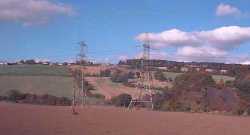COAL MINING
Coal mining went on around Heddon for a period of at least 400 years.
In 1784 a Heddon Colliery was the first in the coal trade to start using mechanical
means of "screening" the coal to separate by size. In 1788 there was a pit on
the south side of the Hexham Road, half way between the Great Hill top and the
Royal French Arms. It was worked to a depth of 30 fathoms. The coal was conveyed
21/2 miles down a Waggon Way to Lemington, to link up with the Waggon
Way from Wylam to Lemmington.
Coal from the pits in Heddon was hauled down the hillside to the
Waggon Way in carts, with a brake man to check the
progress, and the carts were dragged back up the hill by horses.
|
The last deep mine to be worked in Heddon was the Margaret Pit (location
of the Margaret Pit). It was
situated about one kilometer to the south east of the village, in the
valley bottom. It supplied coal to the village and also coal and clay
to the nearby Heddon Brick works.
The Margaret Pit was both a deep mine and a drift mine, with drift workings
going back into the hillside.
|
(Click the image to see a larger version) |
 |
The completion of the Scotswood - Heddon - Wylam branch line gave access
to outside markets. A link line connected the pit and the Brick Works with
the main railway line. In 1902 the pit was sold by the original owner, Mr
Cadwallader J. Bates, to the Throckley Coal company. They continued
to work it until the early 1930's, when it was closed, and the remaining
reserves were accessed from the Throckley Isabella pit.
Coal, for sale locally, was brought up from Heddon Haughs in 7cwt tubs, hauled
up by a wire rope driven by a stationery engine at the pit. At the top of
the Station Road, a wooden building was the coal depot, and coal was
hauled away by horse and cart. The last bungalow on the right (Fairfield)
leaving the village to go done to Heddon Haughs, now stands on the site
of the old coal depot.
The pit also supplied fire-clay for the fire-brick works which was situated
on the same site.
|
(Click the image to see a larger version)
|
The photo on the left shows the site of the Margaret Pit, part of the
remaining slag heap is visible in the bottom right corner.
The field boundary marks the line where the tubs were hauled up to the
top of the hill, to the coal depot.
|
 |
During the period of the second World War the old workshops at Heddon colliery
yard were taken over by Kemsleys as an emergency printing works for the Journals
and Evening Chronicles.
A tilery, making concrete roof tiles, was opened on the site of the pit by
a Major Johnson. The plant was sabotaged by a disgruntled employee, who lived
at Blaney Row - he was sent to prison for it. The tilery had hardly opened
before he ruined the plant which subsequently closed down.
In 1957 the National Coal Board bought Bays Leap Farm, Town House and Heddon
Mill to commence open cast mining. 70 acres of land was excavated to a depth
of 200 feet to extract 2.5 million tons of coal
(site before
mining and open cast site). The land was returned to farming in 1965.

